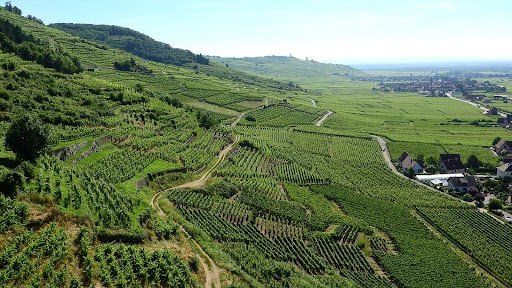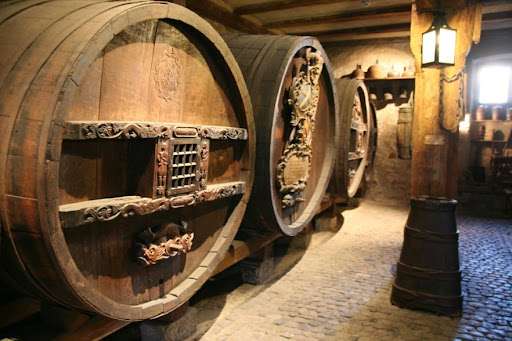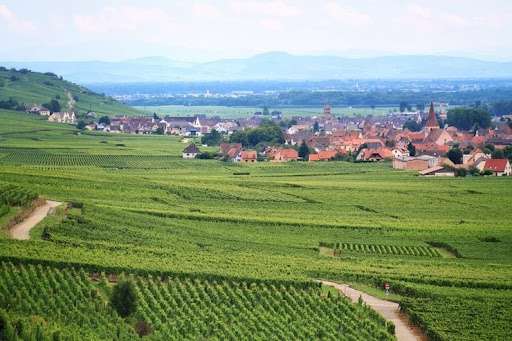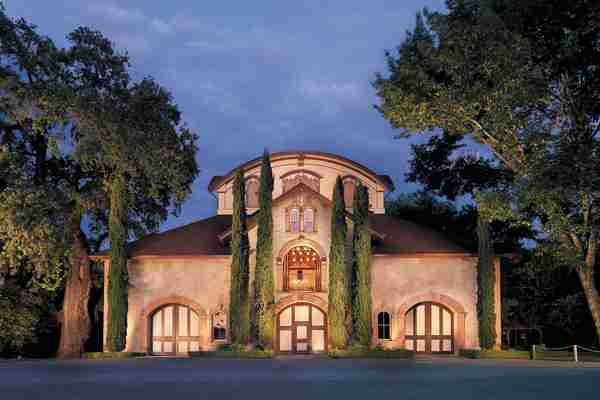Your Ultimate 2023 Guide To The Alsace Wine Region (With Map)
The Alsace wine region is a magnificent and under-appreciated wine-producing region in France, nestled on the Rhine’s east bank gem. The Alsace wine region is so special because the wine production is almost only white wine, which is quite rare. Riesling, Gewürztraminer, Pinot Blanc, Pinot Gris and Muscat are just a few of the seven Alsatian grape varietals to make its world-famous dry white wines on this complex geology.
In this guide we’ll talk history, famous Alsace wine and top 10 wine tastings and tours on the Alsace Wine Route.
Alsace Wine Region Table Of Contents:
- Alsace Wine Region Varietals
- Map Of The Alsace Wine Region
- Top 10 Alsace Wine Region Tours And Tastings
Alsace has a long and illustrious history that dates to Roman times. We’ll take a deeper look at the Alsace wine area and learn more about its history, from winemaking practices to what makes this region so famous?

Where is the alsace wine region?
The Alsace wine region’s natural boundaries are the Vosges Mountains to the west. The region to the south of Alsace are the Jura Mountains and the Jura wine region.
Switzerland lies to the south of Alsace, and Germany and the Rhine River borders it to the east and north.
Alsace is one of the more fertile regions in central Europe. The hills are generally richly wooded, mostly with fir, beech, and oak.
Annual rainfall ranges from 20 to 28 inches (500 to 700 mm) which is low, because the Vosges Mountains protect it from the west.
What is the elevation of Alsace?
The highest point in Alsace is the Grand Ballon in Haut-Rhin, which reaches a height of 4678′ above sea level.
Alsace Wine Region History
Alsace’s wine region has been shaped by its unique location on the French-German border. Because of their proximity, the two countries have had a long history of fighting, which has had a profound impact on the Alsace wine area. Although wine did not originate in the Alsace wine region, it has unquestionably been appreciated in the area from the dawn of civilization. The Romans, who ruled Alsace from 58 BC, were the first to plant vines in the region.
Alsace formed part of the Germanic kingdom of Francia after the Roman Empire fell. In AD 443, the Franks conquered Alsace, and in AD 911, it became part of the Kingdom of France.
Only in the last century, Alsace’s ownership has changed between these countries four times. With the restoration of peace after the 30 Years’ War and border conflict, grape farming began to reclaim its former splendor.
The Alsace wine region has been annexed because of these fights and the regulations have been impacted both by French and German culture and winemaking practices as well.
Alsace Winemaking Traditions
The Alsace wine region has many historical winemaking practices . Wine is made on the land, and this region’s historic growers are aware of this. The growers put additional effort into their work, like the trellising and training systems to protect vines against frost damage, or minimizing the use of chemicals. The use of barrel fermentation is one of the most distinguishing characteristics of Alsace wine too.

Dry white wines with a robust body and rich taste characteristics are made using this winemaking process with a deep respect for the land.
Alsace is also one of the rare regions in France where single-varietal wines are produced. This means that just about every Alsace wine is produced entirely from one grape type.
Alsace’s Different AOCs
- Alsace AOC (mostly white still wines) has 67% of all production
- Crémant d’Alsace AOC (sparkling white and rosé wines) has 29% of production
- Alsace Grand Cru AOC (Limited special vineyard wines), there are 51 Grand Crus and has the 4% of production
The Alsace wine region runs north to south on a strip next to the Vosges Mountains, which protects the area from heavy rain or other severe weather conditions. Most of the vineyards are south facing on a dream soil.
Alsace is divided into three regions under the French AOC (Appellation d’Origine Contrôlée) regulation. Everything about wine, from the grape varieties, vineyard density, and the technique of winemaking is regulated by these laws (i.e., how far apart vines or varieties are from one another).
As a result, while buying a bottle of wine, it’s essential to be conscious of the three Alsace regions.
Alsace Wine Region Varietals
Alsace wine region’s famous varietals are Riesling, Gewürztraminer, Pinot Blanc and Muscat, just a few.
What is Alsace’s most widely planted grape?
Alsace’s most widely planted grape type is Riesling and it’s used to make very dry and ageable white wines with a crisp, refreshing flavor.
Another Alsatian grape type, Gewürztraminer, is used to make ultra-rich and fragrant white wines with aromas of grapefruit, lychees, stone, and marmalade.
Pinot Blanc is an adaptable white wine grape that can be used to produce either dry and light or sweet wines with baked apple flavors.
Muscat is an aromatic grape variety that is widely used in dessert wines. In the region, there are two varieties of Muscat: little berry white muscat (Muscat blanc a petits grain), which has flowery and citrus tastes, and Muscat Ottonel, which has lower acidity.
Styles of Wine From The Alsace Wine Region
Alsace is most renowned for its dry white wines, but it also produces a wide range of other wine varieties. Still, sparkling, dessert, and fortified wines are the four main types of Alsace wines.

Still wines, has pure fruit flavors. They are bold, high in acidity, and usually fermented with indigenous yeasts. The traditional Champagne method is used to make sparkling Alsace wines, that are usually white.
Super concentrated dessert wines are usually produced from Muscat grapes and are extremely fragrant. They could be noble rot affected and late harvest Vendange Tardive (VT) Selection de Grain Nobles (SGN). These exceptional wines are produced only in the best years.
As other wines, this type of wine has also strict regulations such as the intention declaration before production, but they are among the region’s most expensive wines.
What is happening now is that almost half of the products have organic certification and are members of World-Friendly production.
Visiting The Alsace Wine Region

The Alsace wine region is a stunningly beautiful and historically significant area with plenty to see and do. The stunning vineyards, half-timbered houses, and stunning local food such as Kugelhopf-sweet rolls or flammekueche-a type of bread are awaiting you.
There are a few things to bear in mind if you’re planning a trip to the Alsace wine region. First and foremost, because the Alsace wine region is located on the Rhine’s east bank, it is ideal to visit during the summertime when the weather is favorable. Second, Alsace is a French-speaking region, so learning the basics of French should be a must before visiting.
Finally, the Alsace wine area is home to a diverse array of wineries, so do your research and organize ahead of time!
Map of the alsace wine Region
Top 10 Alsace wine Region tours and Tastings
We’ve listed the top 10 Alsace wine tours along the Alsace Wine Route. We recommend you bookmark this page and come back when you’re ready to book. Nobody likes hand written notes. Especially the one taking the notes.
- Take a Small-Group half day tour from Strasbourg. What’s Included: Pick your meeting point. Enjoy the landscape as you drive along the Alsace Wine Route to visit two towns with two Alsace wine tastings including Gewürztraminer and Riesling, the OG varietals of Alsace. Meet the winemakers and tour a wine cellar.
- This full day wine tasting tour along the Alsace Wine Route leaves from Strasbourg. You’ll love visiting the towns of Dambach-la-Ville, Ribeauvillé, Mittelbergheim and Riquewihr. Sample wines from three different wineries. After a stop for lunch you’ll head to Ribeauvillé-Riquewihr wine area. There are five grands cru here — Kirchberg, Osterberg, Geisberg, Schoenenbourg and Sporen.
- Feel like going out on your own? Domaine François Schwach is a family owned winery just south of Strasbourg. You’ll start with a tour to see how the wine is made followed by a wine tasting of 6 wines.
- Are you heading to France for the Christmas festivals? If not, you should. Maison ZEYSSOLFF, just south of Domaine François Schwach, in Gertwiller in the Alsace wine region, has wonderful Christmas festivities. Maison ZEYSSOLFF is one of the few cellars in Alsace still using 100 year old casks. Admission to the gingerbread palace is included and you’ll even leave with a small bottle of mulled wine. Snacks included also!
- After you leave ZEYSSOLFF make a stop at Domaine Achillée, just south of Alsace. They offer wine tasting and tours daily for under $10.
- Private wine tasting tour with locals! This tour explores the history, culture and foodie scene in a Tesla X. We recommend taking this tour on your first full day in the region. You’ll get tons of tips on where to eat, what to see and even hikes if you’re into that sort of thing.
- This half day tour leaves from Colmar. You’ll travel the Alsace wine route from the south to visit two wineries with two tastings. Discover the differences between grape varietals such as Riesling, Pinot Gris and certainly Gewürztraminer.
- Alsace Villages & Wine Tasting Private Day Trip from Strasbourg. This wine-themed tour of the Alsace wine region makes a stop at the Castle of Haut Koenigsbourg for a wine tasting. Walking tours of local towns are included. You will also stop for a 3 course lunch (at your own expense).
- Feel like a tour de France rider (sort of) on a private bike tour through Alsace vineyards and wine villages. Sign us up! On this 2-3 hr bike tour you’ll discover picturesque villages like Eguisheim and Gueberschwihr and cycle past grand cru vineyards. Top it off with a guided wine tasting.
- Are you hoping to see Alsace from Basel? Take a half-day or full-day trip to small boutique, family-owned wineries in the Alsace wine region. Learn about the wines, the regional history and geography in a small group, strictly limited to 2-6 people.
want to bring your wine from alsace home with you?
We recommend the VinGardeValise 12 bottle wine suitcase. There are a couple ways you can use this suitcase. One is, when you come home you only pack half the suitcase with wine and the other side clothes; or, what we do is bring a duffle bag to carry our clothes home. You can still check a duffle bag home btw, you don’t have to schlep it around for all four connections.
Pro tip: you can also use the duffle bag to drop off your clothes to be laundered if you’re doing an extended trip. Multiple uses for one duffle bag.
Alsace Wine Region FAQ
What wine region is Alsace?
Alsace is a magnificent and under-appreciated wine-producing region in France, nestled on the Rhine’s east bank gem.
What makes Alsace special is the production of almost only white wine, which is quite rare. Riesling, Gewürztraminer, Pinot Blanc, and Muscat are just a few of the seven Alsatian grape varietals to make its world-famous dry white wines on this complex geology.
What is Alsace wine famous for?
Alsace is most renowned for its dry white wines, but it also produces a wide range of other wine varieties. Still, sparkling, dessert, and fortified wines are the four main types of Alsace wines.
Is Alsace sweet or dry?
Another Alsatian grape type, Gewürztraminer, is used to make ultra-rich and fragrant white wines with aromas of grapefruit, lychees, stone, and marmalade. Pinot Blanc is an adaptable white wine grape that can be used to produce either dry and light or sweet wines with baked apple flavors.
Is Alsace wine French or German?
Alsace is a magnificent and under-appreciated wine-producing region in France, nestled on the Rhine’s east bank gem.










